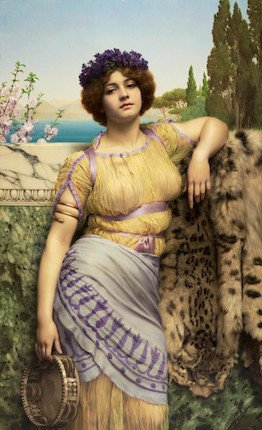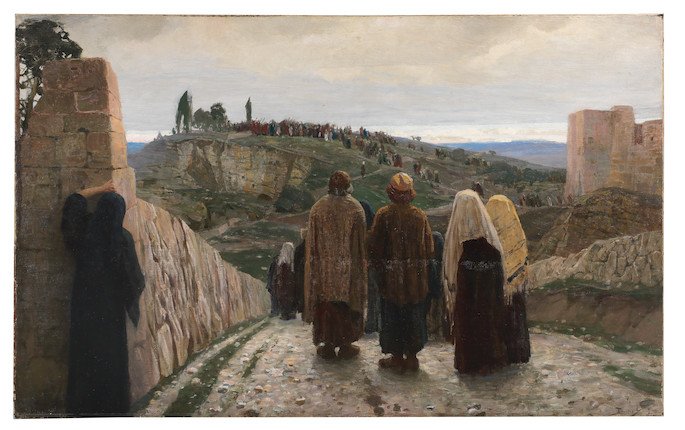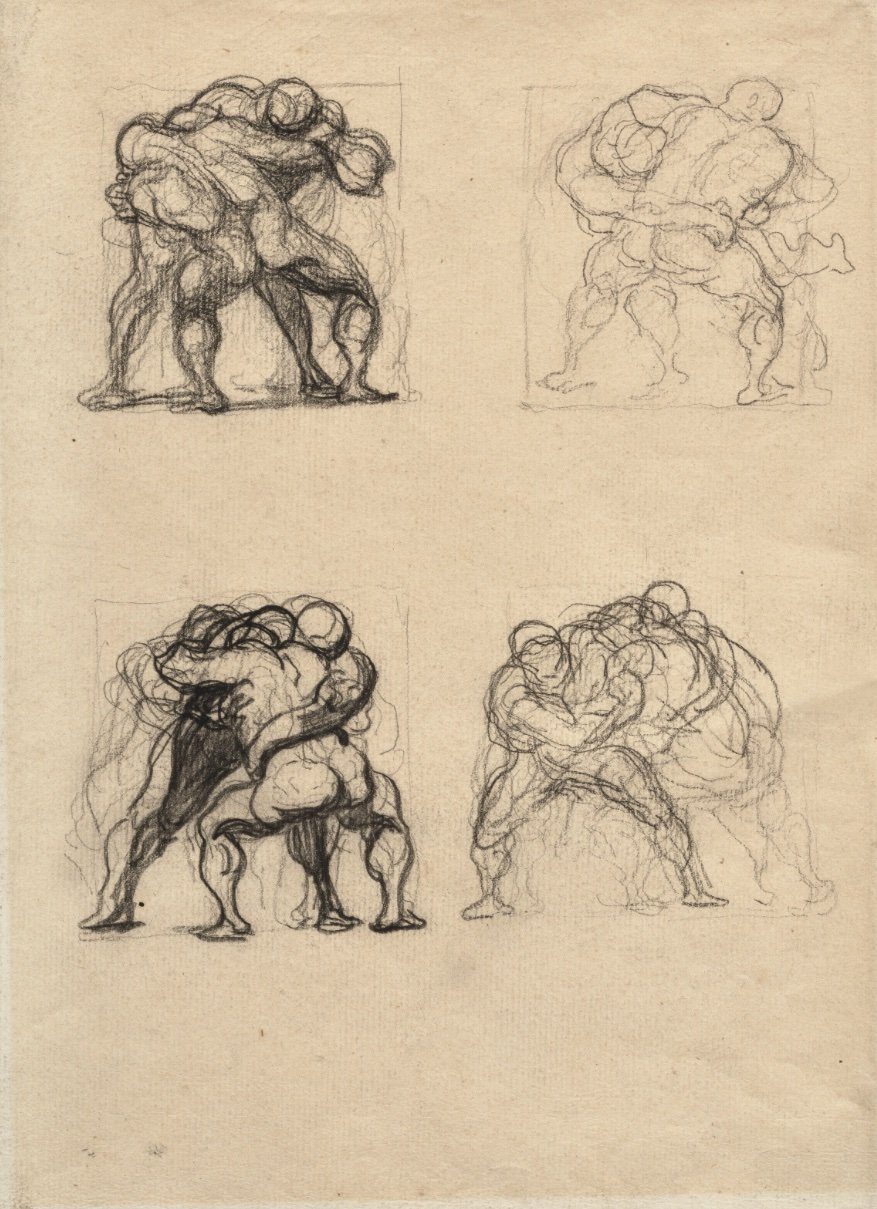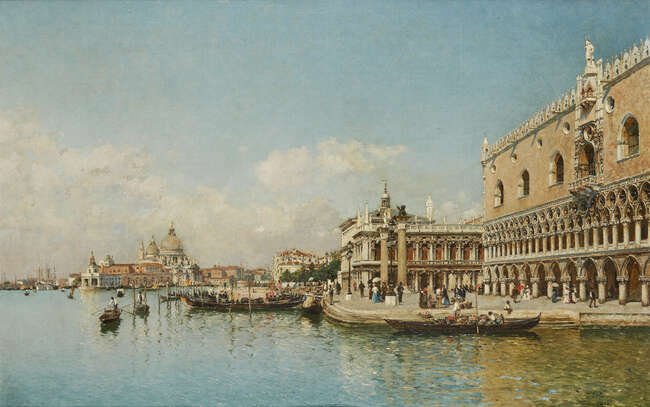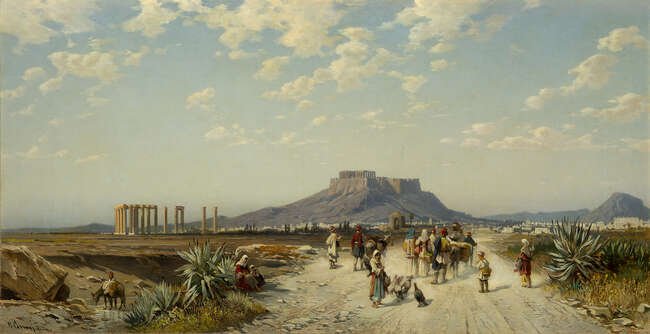Mid-Season Auction Sales: A Focus on 19th Century European Art
Surprising, but never at the top of the headlines, sometimes disappointing but rarely controversial, prestigious while discrete, nineteenth-century European Art Auction Sales are the most paradoxical yet exciting auctions to follow.
The best time to observe these high-quality artworks is during the mid-season sales in the auction world, usually held between March and April. Although calmer than the anticipated Christmas and Summer seasons, respectively, in December and June-July, they are not to be missed.
John William Godward (RBA, British, 1861-1922), Ionian Dancing Girl, 1902, oil on canvas, 137,2 x 83,2 cm. Lot 46 of the Bonhams auction (est. £800,000 - £1,200,000), it was unsold. © Bonhams.
This year’s mid-season sales did not fail to highlight nineteenth-century European Art globally, notably between London and Paris, representing the two main selling places for this specific market.
The most recent sale in this auction season was Bonhams’ biannual 19th Century and British Impressionist Art auction, which occurred in March 2023 [1]. Held in New Bond Street, London, the sale’s advertising strategy was centred around the painting Ionian Dancing Girl by British Victorian artist John William Godward (1861-1922). Described as ‘exceptional’ and ‘Godward’s finest achievements and undoubtedly among the most impressive works by the artist to come to auction in recent history’, the painting also had the highest price estimate in the sale, with a value range of £800,000 - £1,200,000 [2].
To much surprise, the star lot did not sell, which provoked some whispered sighs of astonishment amongst bidders watching live in the viewing room. By contrast, the Russian school and its artworks were the features of the sale, especially with the 1908 picture. There were also women looking from afar off by Vasilii Dmitrievich Polenov (1844-1927), which was sold for £1,542,300, including buyer’s premium, for a £500,000-700,000 estimate range [3]. Another auction win was achieved with a portrait by British artist William Clarke Wontner (1857-1930), which tripled its estimation, selling for £50,700, including buyer’s premium.
Vasilii Dmitrievich Polenov (Russian, 1844-1927), There were also women looking from afar off, 1908, oil on canvas, 105 x 167 cm. Sold for £1,542,300 inc. premium (lot 33). © Bonhams.
Indeed, the British painters, very prominent in this sale, did not disappoint. The Pre-Raphaelites and their associates, who are rarely seen in the art market, all sold within or above their price estimations. Frederic Leighton’s Sea Echoes, a study by Dante Gabriel Rossetti, John Everett Millais’ portrait of his daughter Effie James, and a landscape by John Ruskin had exceptional results for artworks usually exhibited at Tate Britain rather than commercialised on the market. Its current exhibition, The Rossettis (on display until 24 September 2023), surely revitalised these artists with institutional exposure, impacting their markets.
Frederic, Lord Leighton (PRA, British, 1830-1896), Sea Echoes, oil on canvas, 51,5 x 44,5 cm. Sold for £403,500 inc. premium (lot 42). © Bonhams.
Dante Gabriel Rossetti (British, 1828-1882), Study for the portrait of Maria Leathart, 1862, pencil, 33 x 27,6 cm. Sold for £48,180 inc. premium (lot 43). © Bonhams.
Moreover, Bonhams’ auction represented and sold an overview of nineteenth-century European art, with lots sold from the Austrian, Belgian, Croatian, Dutch, French and Italian Schools. The movements represented were also as varied as the artists’ nationalities, with Impressionism, Orientalism, Fairy and Animal Painting. In addition to this, artworks by British artists Dorothea Sharp (1874-1955) and Emily Williams (1869-1890) more than doubled their estimated prices. These exceptional results highlight a slow but growing interest from auction houses and collectors for women artists [4].
Emily Williams (British, 1869-1890), The drawing room, Townshend House (left, lot 54) and The studio from the side entrance, Townshend House (right, lot 55), oils on panels, 82 x 19 cm. Sold for £15,300 and £63,300 inc. premium. © Bonhams.
Across the Channel, another auction sale was dedicated to nineteenth-century European Art by the French auction house Osenat [5]. Its L’Esprit du XIXème siècle auction offered mostly artworks by great and small Romantics, Realist, and Impressionist masters, who were also of the Barbizon School.
Among the 267 lots offered for sale, 188 were sold, and within this 70% of works sold, most fell within or above their estimations. Contrary to the more established and internationally renowned auction house Bonhams, which usually organises smaller sizes auctions characterised by high-quality Old Master artworks, Osenat offers an increased number of lots, primarily by less-known artists. Therefore, the French auction house’s position is to sell (re)discovered pictures from artists forgotten or neglected by Art History, always with the idea for collectors to do a bonne affaire (to make a good deal) thanks to relatively affordable prices, usually going from hundreds to €10,000.
However, some exceptions can be met. Like its British counterpart, the Ionian Dancing Girl by John William Godward, the most valued work of the Osenat’s auction, a painting by Théodore Géricault (1791-1824), also did not find a buyer. Indeed, the 1818 Portrait of Théodore Lebrun by the infamous French and short-lived Romantic painter was estimated to be worth between €100,000 - 150,000 but did not meet success.
Théodore Géricault (French, 1791-1824), Portrait of Théodore Lebrun, 1818-1819, oil on canvas, 61 x 50 cm. Lot 175, unsold. © Osenat.
Nevertheless, this nineteenth-century painter was still a significant auction highlight, if only to say it was the headliner of these mid-season sales. He was massively publicised with the Elmore Collection sale offered by Sotheby’s Paris [6].
This exceptional sale comprised seven works, testifying to the friendship between the artist and the Elmores, a London-based couple who commissioned the works from the artist and has remained in the family collection for more than 200 years [7]. A Sotheby’s statement notably presented the auction as the following: ‘The discovery of works by Gericault from the Elmore collection, which has not been shown or exhibited for more than fifty years, is a key event for all admirers of the artist and nineteenth-century European painting.’ [8].
While staying with Adam Elmore (1784-1849), a horse dealer, and his wife Zoé, daughter of the French businessman Armand Séguin, at their home in London in 1821, Géricault formed a close friendship with the couple. During his time in the UK, he also developed his equine portrayal techniques, studying the thoroughbreds owned by Elmores.
The works consigned included Adam Elmore on the beach (estimate €400,000-€600,000), a full-length portrait, which Sotheby’s says ‘reflects the influence of British painting on [Géricault's] art’. Portrait of Zoé Elmore, painted in 1821, carried the highest estimate of €800,000-€1,200,000; another work, Zoé on riding side-saddle (1821), showed the side-saddled rider galloping against a darkening sky (est €400,000-€600,000). To see portraits by Géricault on the market is equally interesting and exciting because the Romantic artist did not paint many works. The inaccessibility of the results, which Sotheby’s hasn’t publicised, however, makes it difficult to measure his market profitability.
Théodore Géricault, Portrait of Zoé Elmore, 1821, oil on canvas, 65,5 x 55 cm. Estimated €800,000-1,200,000 (lot 202). © Sotheby’s.
Théodore Géricault, Portrait of Adam Elmore on the beach, 1821, oil on canvas, 51,2 x 34,2 cm. Estimated €400,000-600,000 (lot 203). © Sotheby’s.
Held the same day as the Elmore collection auction, Sotheby’s Paris offered more nineteenth-century paintings, this time from the Asbjorn Lunde collection [9]. The nineteenth-century landscape pictures were offered for sale with Old Master paintings from the sixteenth, seventeenth and eighteenth centuries in this eighty-lot auction.
It is indeed a recurring practice in the auction world to combine Old Master and nineteenth-century pictures in one single sale. Sotheby’s London [10], Artcurial [11] and Aguttes [12] in Paris offered this type of auction structure, for instance. Usually, the artworks exhibited in these sales are iconographically closer to Old Master pictures and therefore related to Neoclassicism or Romanticism. This is, some would say, sometimes a more effective way to promote and give more visibility of nineteenth-century European art to the public by linking it to the prestigious but also elite Old Master sector. At the same time, this distinguishes it from the Impressionist and Modern art auctions, which attract different tastes and types of collectors.
This theory can be proven to be true if a closer look is focused on the description and sale result of The Death of Marat, after Jacques Louis David, which was offered for sale by Aguttes. Despite the mysterious attribution of this oil on canvas, it was sold for €106,600, above its estimation, probably thanks to a precise provenance and authentication work from the French auction house. Indeed, the auction house emphasises their research and authentication efforts, stating that ‘using scientific methods, the work could be dated using various imaging techniques applied to the work including visible, grazing and ultraviolet light photography, infrared reflectography and X-ray radiography’, according to the lot description. These methods are not unlike those used for Old Master paintings, showing a positive effect of bringing the latter and nineteenth-century art together.
French School after Jacques Louis David (French, 1748-1825), The Death of Marat, after 1840, oil on canvas, 77 x 91,3 cm. Estimated €40,000 - 60,000, it was sold for €106,600 (lot 70). © Aguttes.
However, sometimes including nineteenth-century into Old Master auctions is not as beneficial as it seems.
Could The Study for a portrait of a young girl with an Indian page and parrot by David Wilkie (1785–1841) and Vittorio Reggianini’s The Letter (1858–1938) have had better results or visibility and acknowledgement if Sotheby’s had included them in an Orientalist sale for the former, or a nineteenth-century painting auction highlighting Victorian art for the latter? Probably. If the famous auction house chooses to sell them online, it’s presumably to attract new buyers in a less-pressured way, which has its advantage. However, the most efficient strategy for promoting nineteenth-century European artworks at auctions is to organise sales dedicated exclusively and only to them, as other market categories do.
Other major auction houses also decided to spotlight nineteenth-century drawings, a category usually overshadowed by painting auctions. In Paris, Christie’s [13] and Tajan [14] sold respectively Les lutteurs by Honoré Victorin Daumier for €107,100 and a drawing by Jean-Léon Gérôme for €1,280.60.
Honoré Victorin Daumier (French, 1808-1879), Les lutteurs, black chalk, 30 x 21 cm. Sold for €107,100 (lot 81). © Christie’s.
Jean-Léon Gérôme (French, 1824-1904), Study for a Neapolitan, pencil, 29 x 18,30 cm. Sold for €1,280.60 (lot 15). © Tajan.
Finally, one cannot forget the smaller auction houses that contribute massively to the influence and promotion of the nineteenth-century art market. For instance, the British auction house Roseberys sold a wonderful view of Venice by Federico del Campo for £46,800 and an exotic landscape by Hermann David Solomon Corrodi representing the Acropolis of Athens for £16,900 in its Old Masters, British & European Pictures auction [15]. Similarly, the New-York based auction house Doyle sold more affordable works by small European masters essentially from the French and German Schools [16].
Federico del Campo (Peruvian, 1837-1927), The Doge's Palace and the Grand Canal, Venice, 1899, oil on canvas, 36 x 55,8 cm. Sold for £46,800 (lot 243). © Roseberys London.
Hermann David Solomon Corrodi (Italian, 1844-1905), The Acropolis, Athens, oil on canvas, 43,2 x 85,4 cm. Sold for £16,900 (lot 251). © Roseberys London.
The mid-season auction sales offered varied nineteenth-century European artworks, generating some surprises and disappointments.
Indeed, some results reinforce the paradox characterising the market for nineteenth-century European Art. The unsold Ionian Dancing Girl by Godward and Portrait of Théodore Lebrun by Géricault are among them since, despite the intensive work spent on their descriptions and advertisements, they were not the ones which attracted collectors the most.
On the contrary (and this is what makes this sector paradoxical whilst exciting), significant sales often focus attention on (re)discoveries thanks to more frequent extensive work on provenance research and authentication processes, like the use of scientific methods, from auction houses.
Furthermore, nineteenth-century European Art is a growing competitive market, especially regarding the high quality of the works and diversity (genres, formats, movements, schools, gender). This is precisely why this market should continue to gain more autonomy and independence. And it will, slowly but surely, within the auction world due to the emergence of its dedicated sales.
Footnotes:
[1] Bonhams, 19th Century and British Impressionist Art, 29 March 2023, London (Live, Sale number: 28103).
[2] Bonhams, A Closer Look: John William Godward, RBA. Ionian Dancing Girl (https://www.bonhams.com/stories/36224/).
[3] The other Russian artists highlighted in this auction were Ivan Konstantinovich Aivazovsky (1817-1900) and Alexei Alexeevich Harlamoff (1840-1925). Their two pictures (lots 34 and 36) sold for a combined price of £126,600, including the buyer’s premium.
[4] Playmates by Dorothea Sharp, for instance (lot 72), was sold for £63,300, including the buyer’s premium, for a £20,000 - 30,000 estimation. During this sale, works by Dame Laura Knight (1877-1970) were also sold (lots 69, 70).
[5] Osenat, L’Esprit du XIXème siècle, 18 March 2023, Fontainebleau (Live Auction).
[6] Sotheby’s, Géricault. The Elmore Collection, 23 March 2023, Paris, (Live, Sale number: PF2399).
[7] Gareth Harris, ‘A 200-year-old family collection of largely unseen Théodore Géricault paintings heads to auction’, The Art Newspaper, 10 February 2023, https://www.theartnewspaper.com/2023/02/10/a-200-year-old-family-collection-of-theodore-gericault-paintings-heads-to-sothebys-paris.
[8] Sotheby’s, Géricault. The Elmore Collection, Sale Catalogue, p. 9, https://www.sothebys.com/en/docs/pdf/pf2399-catalogue.pdf.
[9] Sotheby’s, L’Œil infatigable – Tableaux de la collection Asbjorn Lunde, 23 March 2023, Paris (Live, Sale number: PF2329).
[10] Sotheby’s, Old Master & 19th Century Paintings, 30 March - 5 April 2023, London (Online, Sale number: L23030).
[11] Artcurial, Maîtres anciens & du XIXe siècle, 22 March 2023, Paris (Live, Sale number: 4317).
[12] Aguttes, Maîtres Anciens, 28 March 2023, Paris (Live Auction).
[13] Christie’s, Dessins anciens et du XIXe siècle, 22 March 2023, Paris (Live, Sale number: 21641).
[14] Tajan, Old Master Paintings and Drawings, 23 March 2023, Paris (Live Auction).
[15] Roseberys, Old Masters, British & European Pictures, 29 March 2023, London (Live Auction).
[16] Doyle, Fine Art, 5 April 2023, New York (Live, Sale number: 23FA03).
Noémie Ngako
Art Markets Co-Editor, MADE IN BED


